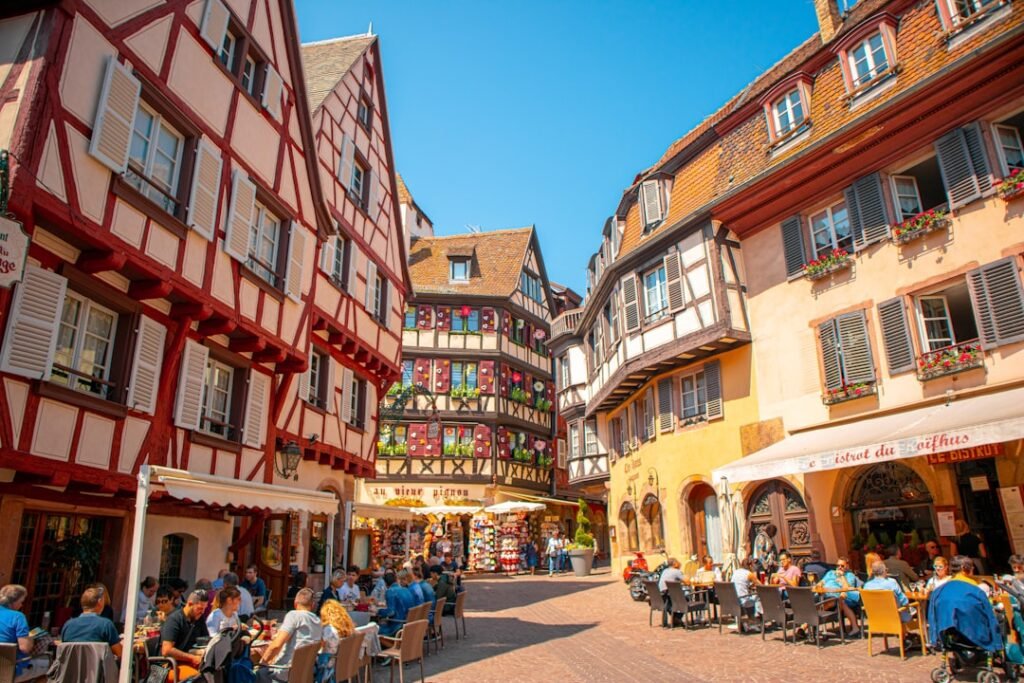

How to Wish Someone a Good Day or a Good Evening in French
As the sun rises and casts its golden rays across the landscape, a simple greeting can set the tone for a productive day. In many cultures, the morning is a time for optimism and fresh beginnings. A warm “Good morning!” can be a delightful way to acknowledge someone’s presence and share a moment of positivity.
This greeting is often accompanied by a smile, which can enhance the warmth of the words spoken. In various languages, the morning greeting takes on different forms, but the essence remains the same: a wish for a good day ahead. In addition to the standard “Good morning,” there are numerous variations that can add a personal touch.
For instance, one might say, “Rise and shine!” or “Top of the morning to you!” These expressions not only convey the same sentiment but also infuse a sense of cheerfulness into the interaction. The way we greet others in the morning can reflect our own mood and intentions, making it an essential part of daily communication. Ready to speak French? Enroll for French classes at the NLS Norwegian Language School in Oslo!
Table of Contents
ToggleSummary
- Start your day with a cheerful “Good morning” to spread positivity
- Wish someone a pleasant evening with a warm “Good evening”
- Use “Good day” in formal settings to show respect and politeness
- Greet friends and family with a friendly “Hi” or “Hey” for a more casual interaction
- When meeting strangers, use polite expressions like “Nice to meet you” to make a good impression
Greetings for a Good Evening
As the day draws to a close and the sky transforms into a canvas of twilight hues, evening greetings take on a different character. “Good evening” is a common phrase that signifies the transition from day to night, often accompanied by a sense of relaxation and winding down. This greeting is particularly significant in social settings, where it serves as an invitation to engage in conversation or share experiences from the day.
Moreover, evening greetings can be enriched with additional phrases that reflect the day’s events or the anticipation of the night ahead. For example, one might say, “I hope you had a lovely day!” or “How was your day?” These expressions not only acknowledge the passage of time but also foster connections between individuals. The evening is often a time for reflection and sharing, making greetings during this period particularly meaningful.
Formal Greetings

In professional settings or formal occasions, greetings take on a more structured form. A simple “Hello” or “Good day” may suffice, but often, individuals opt for more elaborate expressions that convey respect and courtesy. For instance, addressing someone by their title—such as “Mr,” “Mrs,” or “Dr”—followed by their surname is a common practice in formal contexts.
This approach not only demonstrates politeness but also acknowledges the individual’s status or achievements. Additionally, formal greetings may include phrases such as “It is a pleasure to meet you” or “I am honoured to make your acquaintance.” These expressions elevate the interaction and set a tone of professionalism. In many cultures, formal greetings are an essential part of etiquette, reflecting the values of respect and consideration for others.
The choice of words in these situations can significantly impact first impressions and establish a foundation for future interactions.
Informal Greetings
Conversely, informal greetings are characterised by their casual nature and familiarity. Among friends and family, phrases like “Hey!” or “Hi there!” are commonly used to convey warmth and ease. These greetings often reflect the closeness of the relationship and can vary widely based on personal preferences and regional dialects.
Informal greetings allow individuals to express their personality and create an atmosphere of comfort. Moreover, informal greetings can be playful and creative. Expressions such as “What’s up?” or “How’s it going?” invite conversation and encourage a relaxed exchange.
The informality of these greetings often leads to more open discussions, allowing individuals to share thoughts and feelings without the constraints of formality. In essence, informal greetings serve as a bridge between individuals, fostering connections that are both genuine and enjoyable.
Polite Expressions
Politeness is an essential aspect of communication that transcends cultural boundaries. Polite expressions are often employed to show respect and consideration for others’ feelings. Simple phrases like “Please” and “Thank you” are fundamental in maintaining courteous interactions.
These expressions not only convey gratitude but also create an atmosphere of mutual respect. In addition to basic polite expressions, there are more nuanced ways to convey politeness in conversation. For instance, one might say, “Would you mind if
Casual Expressions

Casual expressions are often used among friends and acquaintances to create a relaxed atmosphere. Phrases like “No worries!” or “All good!” convey reassurance and ease in conversation. These expressions reflect a laid-back attitude and can help to diffuse tension in social interactions.
Casual language often includes slang or colloquial terms that resonate with specific groups or communities. Furthermore, casual expressions can vary significantly based on regional dialects and cultural influences. For example, in some areas, one might hear “Cheers!” as a way to say thank you or goodbye, while in others, it may be more common to use “Take care!” These variations add richness to language and highlight the diversity of communication styles across different cultures.
Embracing casual expressions can enhance social interactions and create bonds among individuals who share similar backgrounds or experiences.
Expressions for Friends and Family
When communicating with friends and family, greetings often carry an added layer of affection and familiarity. Phrases like “Hey there!” or “How’s my favourite person?” reflect the closeness of these relationships and create an atmosphere of warmth. Such expressions are often accompanied by physical gestures like hugs or playful nudges, further enhancing the sense of connection.
In addition to standard greetings, individuals may use nicknames or inside jokes that hold special meaning within their circle. For instance, one might greet a sibling with “What’s cooking, good looking?” or refer to a close friend with a unique moniker that reflects shared experiences. These personalised greetings not only strengthen bonds but also create a sense of belonging within families and friendships.
Expressions for Colleagues and Acquaintances
In professional environments, greetings among colleagues and acquaintances tend to strike a balance between formality and friendliness. A simple “Hello” or “Good morning” is often appropriate, but adding a personal touch can enhance workplace relationships. For example, asking about a colleague’s weekend plans or expressing interest in their recent projects can foster camaraderie and collaboration.
Moreover, using colleagues’ names in greetings can create a sense of recognition and respect. Phrases like “Good to see you, Sarah!” or “How have you been, John?” demonstrate attentiveness and encourage open communication. In professional settings where teamwork is essential, these small gestures can significantly impact workplace dynamics and contribute to a positive atmosphere.
Expressions for Strangers
When encountering strangers, greetings typically lean towards politeness and formality. A simple “Hello” or “Good afternoon” is often sufficient to initiate interaction without overstepping boundaries. In many cultures, maintaining a respectful distance while greeting strangers is essential; thus, body language plays a crucial role in conveying openness without intrusiveness.
In addition to standard greetings, one might use phrases like “Pleased to meet you” when introduced to someone new. This expression conveys respect and acknowledges the significance of the encounter. In situations where small talk is appropriate—such as waiting in line or sharing an elevator—comments about the weather or local events can serve as effective icebreakers that ease tension between strangers.
Regional Variations
Language is inherently influenced by geography, leading to regional variations in greetings that reflect local culture and customs. For instance, while “Hello” is universally recognised in English-speaking countries, some regions may favour unique alternatives such as “G’day” in Australia or “Howdy” in parts of the United States. These variations not only enrich language but also provide insight into regional identities.
Moreover, even within countries, dialects can lead to diverse expressions of greeting. In Scotland, one might hear “Hoo’s it gaun?” while in London, a simple “Alright?” suffices among friends. Understanding these regional nuances can enhance communication and foster connections with individuals from different backgrounds.
Cultural Considerations
Cultural context plays a significant role in shaping how greetings are perceived and exchanged across different societies. In some cultures, physical gestures such as handshakes or bows accompany verbal greetings as signs of respect. For instance, in Japan, bowing is an integral part of greeting etiquette that conveys humility and politeness.
Additionally, cultural norms dictate the level of formality required in various situations. In some cultures, addressing individuals by their first names may be considered disrespectful until a certain level of familiarity is established. Understanding these cultural considerations is essential for effective communication and helps avoid misunderstandings that may arise from differing expectations regarding greetings.
In conclusion, mastering the art of greeting involves understanding various expressions tailored for different contexts—be it formal or informal settings—and recognising cultural nuances that shape communication styles around the world. At NLS Norwegian Language School in Oslo, we offer comprehensive French courses that delve into not just language mechanics but also cultural insights essential for effective communication in French-speaking environments. Our courses provide students with practical knowledge on how to navigate greetings appropriately within various social contexts while embracing the richness of French culture.
Whether you are looking to enhance your professional skills or simply wish to connect with French-speaking friends and family more meaningfully, our French courses are designed to equip you with the tools necessary for successful interactions across diverse settings.
Ready to speak French? Enroll for French classes at the NLS Norwegian Language School in Oslo!
If you want to learn Norwegian, you can register for classes here. We look forward to hearing from you and helping you become fluent in Norwegian.





